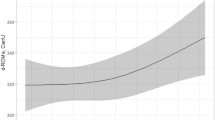Abstract
Our group recently proposed OXY-SCORE, a summary index of oxidative stress, computed by combining plasma free and total malondialdehyde (F- and T-MDA), glutathione in disulphide/reduced forms (GSSG/GSH), α- and γ-tocopherol (TH), urine isoprostanes (iPF2α-III) levels, and plasma individual antioxidant capacity. Here, we describe the methods for the determination of the analytes and for the computation of the scores. We also report the results of two studies testing the performances of OXY-SCORE, and showing its value in assessing the oxidative status of cardiovascular patients and healthy subjects.
Access this chapter
Tax calculation will be finalised at checkout
Purchases are for personal use only
Similar content being viewed by others
References
Droge W (2002) Free radicals in the physiological control of cell function. Physiol Rev 82:47–95
Valko M, Leibfritz D, Moncol J, Cronin MT, Mazur M, Telser J (2007) Free radicals and antioxidants in normal physiological functions and human disease. Int J Biochem Cell Biol 39:44–84
Veglia F, Cighetti G, De Franceschi M, Zingaro L, Boccotti L, Tremoli E, Cavalca V (2006) Age- and gender-related oxidative status determined in healthy subjects by means of OXY-SCORE, a potential new comprehensive index. Biomarkers 11:562–573
Cighetti G, Debiasi S, Paroni R, Allevi P (1999) Free and total malondialdehyde assessment in biological matrices by gas chromatography-mass spectrometry: what is needed for an accurate detection. Anal Biochem 266:222–229
Lawson JA, Rokach J, FitzGerald GA (1999) Isoprostanes: formation, analysis and use as indices of lipid peroxidation in vivo. J Biol Chem 274:24441–24444
Roberts LJ, Morrow JD (2000) Measurement of F(2)-isoprostanes as an index of oxidative stress in vivo. Free Radic Biol Med 28:505–513
Taylor AW, Bruno RS, Frei B, Traber MG (2006) Benefits of prolonged gradient separation for high-performance liquid chromatography-tandem mass spectrometry quantitation of plasma total 15-series F-isoprostanes. Anal Biochem 350:41–51
Morrow JD, Roberts LJ 2nd (1994) Mass spectrometry of prostanoids: F2-isoprostanes produced by non-cyclooxygenase free radical-catalyzed mechanism. Methods Enzymol 233:163–174
Saenger AK, Laha TJ, Edenfield MJ, Sadrzadeh SM (2007) Quantification of urinary 8-iso-PGF2alpha using liquid chromatography-tandem mass spectrometry and association with elevated troponin levels. Clin Biochem 40:1297–1304
Helmersson J, Basu S (1999) F2-isoprostane excretion rate and diurnal variation in human urine. Prostaglandins Leukot Essent Fatty Acids 61:203–205
Li H, Lawson JA, Reilly M, Adiyaman M, Hwang SW, Rokach J, FitzGerald GA (1999) Quantitative high performance liquid chromatography/tandem mass spectrometric analysis of the four classes of F(2)-isoprostanes in human urine. Proc Natl Acad Sci USA 96:13381–13386
Davies SS, Zackert W, Luo Y, Cunningham CC, Frisard M, Roberts LJ 2nd (2006) Quantification of dinor, dihydro metabolites of F2-isoprostanes in urine by liquid chromatography/tandem mass spectrometry. Anal Biochem 348:185–191
Carbonneau MA, Peuchant E, Sess D, Canioni P, Clerc M (1991) Free and bound malondialdehyde measured as thiobarbituric acid adduct by HPLC in serum and plasma. Clin Chem 37:1423–1429
Cavalca V, Sisillo E, Veglia F, Tremoli E, Cighetti G, Salvi L, Sola A, Mussoni L, Biglioli P, Folco G, Sala A, Parolari A (2006) Isoprostanes and oxidative stress in off-pump and on-pump coronary bypass surgery. Ann Thorac Surg 81:562–567
Gerritsen WB, van Boven WJ, Driessen AH, Haas FJ, Aarts LP (2001) Off-pump versus on-pump coronary artery bypass grafting: oxidative stress and renal function. Eur J Cardiothorac Surg 20:923–929
Zou KH, O’Malley AJ, Mauri L (2007) Receiver-operating characteristic analysis for evaluating diagnostic tests and predictive models. Circulation 115:654–657
Goodman M, Bostick RM, Dash C, Flanders WD, Mandel JS (2007) Hypothesis: oxidative stress score as a combined measure of pro-oxidant and antioxidant exposures. Ann Epidemiol 17:394–399
Wright ME, Mayne ST, Stolzenberg-Solomon RZ, Li Z, Pietinen P, Taylor PR, Virtamo J, Albanes D (2004) Development of a comprehensive dietary antioxidant index and application to lung cancer risk in a cohort of male smokers. Am J Epidemiol 160:68–76
Kunt AS, Selek S, Celik H, Demir D, Erel O, Andac MH (2006) Decrease of total antioxidant capacity during coronary artery bypass surgery. Mt Sinai J Med 73:777–783
Acknowledgments
We thank Dr. Isabella Squellerio and Dr. Fabiana Minardi for their kind assistance in preparing the manuscript.
Author information
Authors and Affiliations
Corresponding author
Editor information
Editors and Affiliations
Rights and permissions
Copyright information
© 2010 Humana Press, a part of Springer Science+Business Media, LLC
About this protocol
Cite this protocol
Veglia, F., Cavalca, V., Tremoli, E. (2010). OXY-SCORE: A Global Index to Improve Evaluation of Oxidative Stress by Combining Pro- and Antioxidant Markers. In: Armstrong, D. (eds) Advanced Protocols in Oxidative Stress II. Methods in Molecular Biology, vol 594. Humana Press, Totowa, NJ. https://doi.org/10.1007/978-1-60761-411-1_14
Download citation
DOI: https://doi.org/10.1007/978-1-60761-411-1_14
Published:
Publisher Name: Humana Press, Totowa, NJ
Print ISBN: 978-1-60761-410-4
Online ISBN: 978-1-60761-411-1
eBook Packages: Springer Protocols




